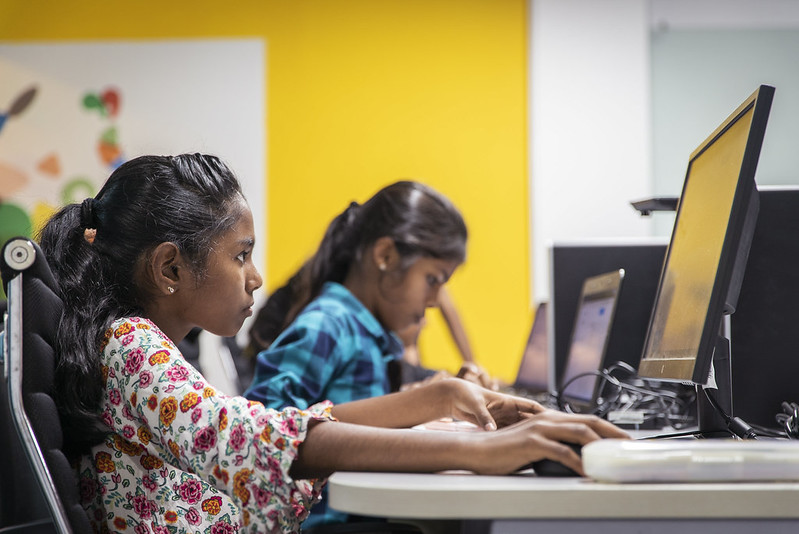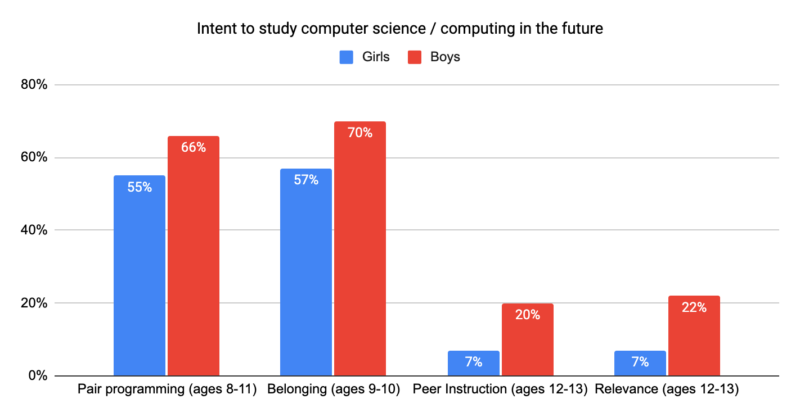The Gender Balance in Computing programme is a 4-year project that has explored a number of different approaches aimed at increasing the number of girls that choose Computer Science at GCSE and A-level. The programme commenced in 2019 and has been a collaboration between the consortium of the Raspberry Pi Foundation, STEM Learning, BCS, The Chartered Institute of IT and the Behavioural Insights Team, along with partners Apps for Good and WISE. The consortium received funding from the Department for Education to run a number of different research studies to develop scalable interventions for use in primary and secondary schools in England.

Barriers to participation
The proportion of girls who choose to study computing for a formal qualification in England remains low.
In 2022, 21.4% of GCSE Computer Science and 14.7% of A-level Computer Science students were girls. This imbalance is even more notable when compared with other subjects such as Maths, Biology, Chemistry and Physics, where at A-level there is a more even split of male and female students.
In England, all pupils currently study computing as a mandatory curriculum subject from the ages of 5–14. From then on, pupils have increasing levels of choice about the subjects that they study in order to gain formal qualifications, and so computing is then a non-compulsory subject. The Gender Balance in Computing programme is based on a review of existing research that identified several systemic barriers that are currently thought to prevent girls from choosing to study computing beyond the age of 14.
There are a number of barriers that can prevent girls from participating in computing, including the current approaches used to teach computing, a lack of role models, and a lack of connections between the theoretical aspects of computing and how these can be applied in the real world. Additionally, there can be societal pressures and cultural norms that discourage girls from pursuing careers in science, technology, engineering, and maths (STEM) fields, including computing. As a result, girls may not receive the same level of encouragement and support as boys when it comes to studying and pursuing careers in these fields.
The trials
The research programme comprised a number of randomised controlled trials (RCTs) that took place in primary and secondary schools in England. Participating schools were randomly divided into a control group, who taught computing to a ’business as usual’ model, and a treatment group, who delivered an intervention that had been designed to overcome a single barrier identified in the literature. The interventions took place for 12 weeks each and were based around the following themes:
- Teaching approach: Two different trials explored the effect of teaching computing using structured, collaborative group work on pupils’ attitudes toward computing. This idea was tested in primary schools with pupils aged 8–11 using a pair programming approach and in secondary schools with pupils aged 12–13 using a peer instruction approach. A storytelling approach to teaching computing was also piloted with 6– 7 year old pupils.
- Belonging: This trial ran with primary pupils aged 9–10 and consisted of two interventions. One intervention tested the effect of introducing role models from computing workplaces and the other explored the role of parental encouragement.
- Relevance: In this trial, an intervention was designed to examine how solving real-world problems using technology would affect secondary school (age 12 and 13) pupils’ attitudes.
- Non-formal learning: This trial explored how young people could connect their learning in non-formal spaces, such as coding clubs, to the skills and knowledge required for formal computing qualifications and study. A primary intervention ran in coding clubs for pupils aged 7–11, and a secondary intervention used app design with pupils aged 12–13.
The effects of the interventions were measured using a pre-post design measured with the Haynie and Packman (2017) Computer Science Attitudes Survey in order to investigate i) pupils’ attitudes towards computing, ii) their intention to study computer programming, and iii) their intention to study science and/or mathematics. Supplemental qualitative data from interviews and observations was collected from some schools to investigate pupil engagement, lesson fidelity, and barriers to lesson delivery. Teacher interviews also focused on the perceived impact of the intervention.
Key themes and findings from the trials
The quantitative data that was collected from the pupil surveys at the start and end of each intervention did not show a statistically significant impact on girls’ intention to study computing in the future, with the exception of the Relevance trial, where for some of the analyses run, there was a statistically significant effect on girls’ likelihood to study GCSE Computer Science. However, several of the RCTs showed a positive impact that fell short of statistical significance, and the qualitative data collected from teachers and pupils indicated that they felt positive about the interventions that had been implemented. Overall, while these research results may be mixed, they are still valuable in providing insight into the types of approaches needed to engage more girls in computing.
When looking at the data collected across the whole programme, one key theme is notable. The mean scores from the survey results suggest that at primary school level, there is a relatively small gender gap in attitudes towards computing. However, by secondary school this gap has widened and girls are starting to become less interested in computing.

(Source: https://www.raspberrypi.org/blog/gender-balance-in-computing-big-picture/)
An example of this gender gap was observed in two of the Teaching Approach trials, when pupils were also asked about their intentions to continue studying computing. In the Pair Programming trial, the participating pupils (in Year 4/6) were asked whether they wanted to study computing in the future, whereas the Year 8 pupils taking part in the Peer Instruction project were asked whether they intended to choose Computer Science as a GCSE subject. We cannot compare these two sets of answers directly, because of the different questions that were asked, but it is noticeable that between the ages of 10–13, girls begin to decide that computing is not a subject that they are interested in because of existing inequity and barriers.
From these findings, there are two key approaches to inform future work in this area:
- A multi-faceted approach is required to address several of the key barriers simultaneously through a range of interventions for pupils, and these need to be delivered consistently over a longer period of time.
- Interventions that target pupils between the ages of 10–13 can play an important role in helping girls to better understand why computing is an important subject, and the role that computing skills can play in their future choices for further study.
Read the reports
The full evaluation reports from the trials can be found at:
| Teaching Approach theme | Storytelling report Pair Programming report Peer Instruction report |
| Belonging theme | Belonging report |
| Relevance theme | Relevance report |
| Informal Learning theme | Primary school intervention report Secondary school intervention report |
Leave a Reply